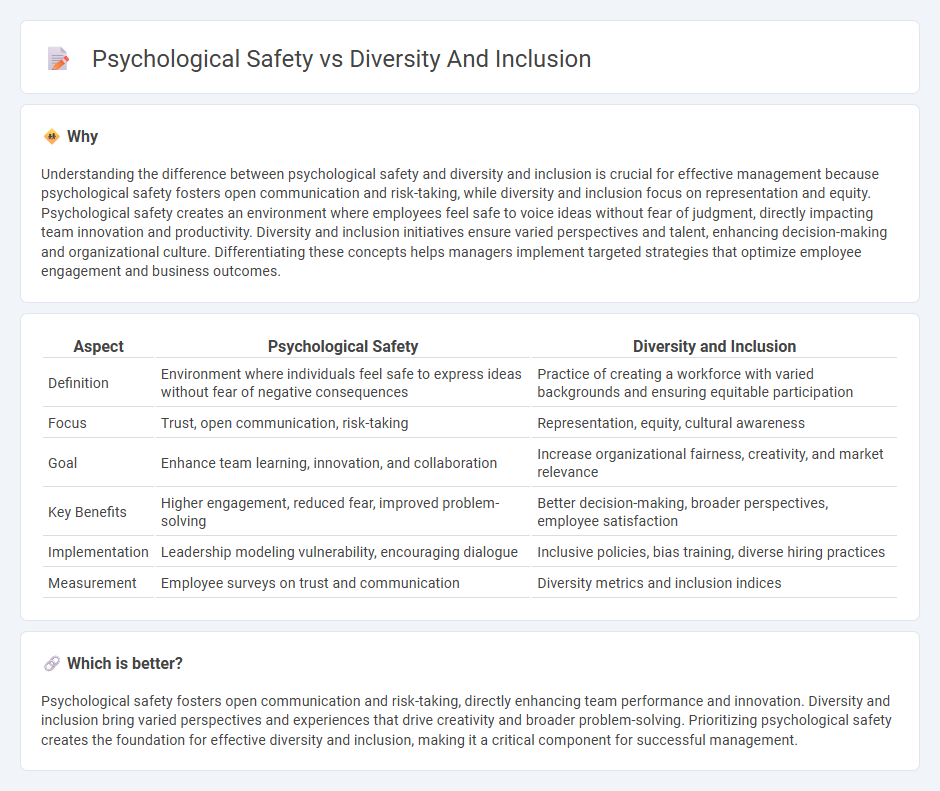
Psychological safety fosters an environment where employees feel secure to express ideas without fear of judgment, directly enhancing team performance and collaboration. Diversity and inclusion initiatives ensure representation and equitable treatment across various demographics, driving innovation and broadening perspectives within organizations. Explore more to understand how integrating psychological safety with diversity and inclusion can transform workplace dynamics and boost productivity.
Why it is important
Understanding the difference between psychological safety and diversity and inclusion is crucial for effective management because psychological safety fosters open communication and risk-taking, while diversity and inclusion focus on representation and equity. Psychological safety creates an environment where employees feel safe to voice ideas without fear of judgment, directly impacting team innovation and productivity. Diversity and inclusion initiatives ensure varied perspectives and talent, enhancing decision-making and organizational culture. Differentiating these concepts helps managers implement targeted strategies that optimize employee engagement and business outcomes.
Comparison Table
| Aspect | Psychological Safety | Diversity and Inclusion |
|---|---|---|
| Definition | Environment where individuals feel safe to express ideas without fear of negative consequences | Practice of creating a workforce with varied backgrounds and ensuring equitable participation |
| Focus | Trust, open communication, risk-taking | Representation, equity, cultural awareness |
| Goal | Enhance team learning, innovation, and collaboration | Increase organizational fairness, creativity, and market relevance |
| Key Benefits | Higher engagement, reduced fear, improved problem-solving | Better decision-making, broader perspectives, employee satisfaction |
| Implementation | Leadership modeling vulnerability, encouraging dialogue | Inclusive policies, bias training, diverse hiring practices |
| Measurement | Employee surveys on trust and communication | Diversity metrics and inclusion indices |
Which is better?
Psychological safety fosters open communication and risk-taking, directly enhancing team performance and innovation. Diversity and inclusion bring varied perspectives and experiences that drive creativity and broader problem-solving. Prioritizing psychological safety creates the foundation for effective diversity and inclusion, making it a critical component for successful management.
Connection
Psychological safety fosters an environment where diverse voices feel valued and confident to contribute without fear of judgment, directly enhancing inclusion. Inclusive management practices leverage psychological safety to encourage collaboration, innovation, and trust among team members from varied backgrounds. Research indicates that organizations with high psychological safety and strong diversity and inclusion frameworks experience improved employee engagement, creativity, and overall performance.
Key Terms
**Diversity and Inclusion:**
Diversity and Inclusion (D&I) initiatives foster representation and equitable treatment of individuals across varied demographics, enhancing innovation and decision-making effectiveness within organizations. These efforts include policies and practices that promote recruitment, retention, and advancement of diverse talent, while cultivating an inclusive culture where all employees feel valued and empowered. Explore further to understand how D&I strategies drive organizational success and workforce engagement.
Representation
Diversity and inclusion emphasize representation by ensuring that various demographic groups are visibly present and valued within an organization, which contributes to a broader range of perspectives. Psychological safety complements this by fostering an environment where individuals feel comfortable expressing unique viewpoints without fear of judgment or retaliation. Explore how integrating representation with psychological safety can enhance workplace innovation and employee engagement.
Equity
Equity-driven diversity and inclusion efforts prioritize fair treatment, access, and opportunities for all individuals, addressing systemic barriers and creating a level playing field. Psychological safety fosters an environment where employees feel secure to express ideas without fear of judgment, enhancing participation among diverse groups. Explore how integrating equity within psychological safety strategies can transform organizational culture and drive innovation.
Source and External Links
Equity, Diversity, and Inclusion - This webpage explains the concepts of equity, diversity, and inclusion as a framework promoting fair treatment and participation of all people, especially those historically underrepresented.
DEI: What It Is & How to Champion It in the Workplace - This article discusses diversity, equity, and inclusion (DEI) as essential for fostering a positive work culture by promoting diversity, ensuring equal access to opportunities, and creating an inclusive environment.
Why Is Diversity and Inclusion in the Workplace Important? - This blog post highlights the importance of diversity and inclusion in the workplace, emphasizing how these elements lead to a more involved and committed workforce, benefiting the organization overall.
 dowidth.com
dowidth.com